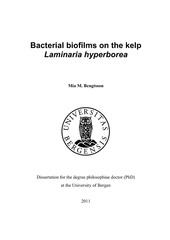| dc.contributor.author | Bengtsson, Mia M. | eng |
| dc.date.accessioned | 2011-03-29T11:17:23Z | |
| dc.date.available | 2011-03-29T11:17:23Z | |
| dc.date.issued | 2011-03-23 | eng |
| dc.identifier.isbn | 978-82-308-1717-9 (print version) | en_US |
| dc.identifier.uri | http://hdl.handle.net/1956/4610 | |
| dc.description.abstract | This thesis deals with bacterial communities in biofilms on the surfaces of the kelp Laminaria hyperborea and their roles in carbon cycling. Kelp forests are characterized by high biodiversity and productivity, and cycling of kelp-produced carbon is a vital yet poorly understood process in this ecosystem. Although bacteria are assumed to play a major role in kelp forest carbon cycling, the knowledge of the composition and diversity of the bacterial communities associated to kelp is limited. L. hyperborea and the bacterial biofilms on its surfaces were sampled at several kelp forest localities in the archipelago near Bergen, Norway at different times of the year. The biology of L. hyperborea is governed by seasonal factors. Its growth, chemical composition and exudation of dissolved organic carbon changes substantially during the course of the year. The seasonal dynamics of the biofilms were addressed in Paper I, using genetic fingerprinting and microscopic cell counting. There was a clear seasonal cycle of the bacterial community composition. The cell density of the biofilms on the lamina was the lowest during the active growth period of the kelp in spring. The diversity of the bacterial communities was also influenced by the seasonal growth cycle of the kelp. This was shown using pyrosequencing of the 16S rRNA gene in Paper IV, revealing that bacterial species richness and evenness increased with kelp surface age. Bacteria belonging to Planctomycetes were frequently detected on kelp surface biofilms throughout the year. In Paper II, this bacterial group was found to be numerically dominant on kelp surfaces using fluorescence in situ hybridization (FISH). Several different lineages within Planctomycetes were detected using 16S rRNA gene clone libraries, and the most abundant clones belonged to yet uncultivated lineages. The biomass and exudates of kelp contain large quantities of organic material, such as polysaccharides, which may provide rich carbon sources for heterotrophic bacteria on kelp surfaces. By utilizing such kelp-derived carbon, these bacteria can play an important role in the ecosystem by contributing to carbon cycling. However, it is not known which bacteria are important in these processes and which carbon sources they utilize. The ability of kelp surface bacteria to utilize different kelp substances was investigated in Paper III using an enrichment cultivation approach. Several bacterial strains were recovered by cultivation using a variety of kelp substances. The most abundant of these were generalists, utilizing all kelp substances tested. The same 16S rRNA gene phylotypes as some of the cultured bacterial strains were also detected in kelp surface biofilms using culture-independent methods. This suggests that the cultured bacteria may also play significant roles in kelp forests. The secondary production rate of kelp surface bacterial communities was investigated in Paper IV using incorporation of tritiated thymidine. Higher bacterial production was correlated with higher diversity of the bacterial communities, measured as evenness of bacterial phylotypes using pyrosequencing of the 16S rRNA gene. This shows that the composition and diversity of the bacterial community can influence bacterial production rates, and thereby have implications for kelp forest carbon cycling. The work presented in this thesis is the first to describe the bacterial communities associated to an important kelp forest forming species. The results provide a foundation for understanding the microbial ecology of kelp forests and raise several new questions about the symbiotic roles and ecosystem impacts of bacteria on kelps and other seaweeds. | en_US |
| dc.language.iso | eng | eng |
| dc.publisher | The University of Bergen | en_US |
| dc.relation.haspart | Paper I: Aquatic Microbial Ecology 60(1), Bengtsson, M. M.; Sjøtun K.; Øvreås, L., Seasonal dynamics of bacterial biofilms on the kelp Laminaria hyperborean, pp. 71-83. Published version. Copyright Inter-Research 2010. The published version is also available at: <a href="http://dx.doi.org/10.3354/ame01409" target="blank"> http://dx.doi.org/10.3354/ame01409</a> | en_US |
| dc.relation.haspart | Paper II: BMC Microbiology 10:261, Bengtsson, M. M. and Øvreås, L., Planctomycetes dominate biofilms on surfaces of the kelp Laminaria hyperborea. Published version. Copyright 2010 Bengtsson and Øvreås; licensee BioMed Central Ltd. The published version is also available at: <a href="http://dx.doi.org/10.1186/1471-2180-10-261" target="blank"> http://dx.doi.org/10.1186/1471-2180-10-261</a> | en_US |
| dc.relation.haspart | Paper III: Aquatic Microbial Ecology 62(2), Bengtsson, M. M.; Sjøtun K.; Storesund J. E.; Øvreås, L. Utilization of kelp-derived carbon sources by kelp surface-associated bacteria, pp. 191-199. Accepted version. Copyright Inter-Research 2010. The published version is available at: <a href="http://dx.doi.org/10.3354/ame01477" target="blank"> http://dx.doi.org/10.3354/ame01477</a> | en_US |
| dc.relation.haspart | Paper IV: Bengtsson, M. M.; Sjøtun K.; Lanzén, A.; Øvreås, L. Bacterial diversity and production on the surfaces of the kelp Laminaria hyperborea. Draft version. Submitted to Environmental Microbiology. | en_US |
| dc.title | Bacterial biofilms on the kelp Laminaria hyperborea | en_US |
| dc.type | Doctoral thesis | |
| dc.rights.holder | The author | en_US |
| dc.rights.holder | Copyright the author. All rights reserved | en_US |
| dc.subject.nsi | VDP::Mathematics and natural science: 400::Zoology and botany: 480::Marine biology: 497 | en_US |
